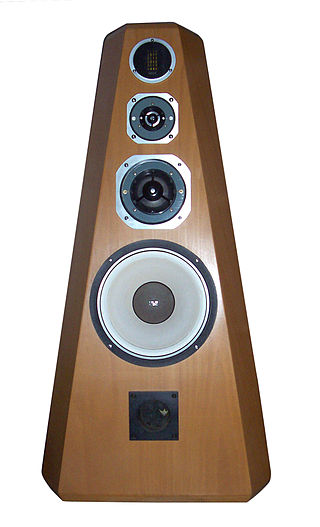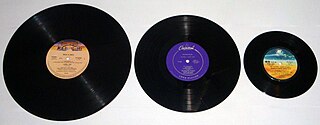Related Research Articles

High fidelity is the high-quality reproduction of sound. It is popular with audiophiles and home audio enthusiasts. Ideally, high-fidelity equipment has inaudible noise and distortion, and a flat frequency response within the human hearing range.

A phonograph record or a vinyl record is an analog sound storage medium in the form of a flat disc with an inscribed, modulated spiral groove. The groove usually starts near the outside edge and ends near the center of the disc. The stored sound information is made audible by playing the record on a phonograph.

Albert Edwin Condon was an American jazz banjoist, guitarist, and bandleader. A leading figure in Chicago jazz, he also played piano and sang. He also owned a self-named night club in New York City.

Monaural sound or monophonic sound is sound intended to be heard as if it were emanating from one position. This contrasts with stereophonic sound or stereo, which uses two separate audio channels to reproduce sound from two microphones on the right and left side, which is reproduced with two separate loudspeakers to give a sense of the direction of sound sources. In mono, only one loudspeaker is necessary, but, when played through multiple loudspeakers or headphones, identical audio signals are fed to each speaker, resulting in the perception of one-channel sound "imaging" in one sonic space between the speakers. Monaural recordings, like stereo ones, typically use multiple microphones fed into multiple channels on a recording console, but each channel is "panned" to the center. In the final stage, the various center-panned signal paths are usually mixed down to two identical tracks, which, because they are identical, are perceived upon playback as representing a single unified signal at a single place in the soundstage. In some cases, multitrack sources are mixed to a one-track tape, thus becoming one signal. In the mastering stage, particularly in the days of mono records, the one- or two-track mono master tape was then transferred to a one-track lathe used to produce a master disc intended to be used in the pressing of a monophonic record. Today, however, monaural recordings are usually mastered to be played on stereo and multi-track formats, yet retain their center-panned mono soundstage characteristics.

Contemporary Records was a jazz record company and label founded by Lester Koenig in Los Angeles in 1951. Contemporary produced music from a variety of jazz styles and players.

Mobile Fidelity Sound Lab is a record label that specialized in the production of audiophile issues. The company produces reissued vinyl LP records, compact discs, and Super Audio CDs and other formats.

Stereophonic sound, or more commonly stereo, is a method of sound reproduction that recreates a multi-directional, 3-dimensional audible perspective. This is usually achieved by using two independent audio channels through a configuration of two loudspeakers in such a way as to create the impression of sound heard from various directions, as in natural hearing.

Robert Sage Wilber was an American jazz clarinetist, saxophonist, and band leader. Although his scope covers a wide range of jazz, Wilber was a dedicated advocate of classic styles, working throughout his career to present traditional jazz pieces in a contemporary manner. He played with many distinguished jazz leaders in the 1950s and 1960s, including Bobby Hackett, Benny Goodman, Sidney Bechet, Jack Teagarden and Eddie Condon. In the late 1960s, he was an original member of the World's Greatest Jazz Band, and in the early 70s of Soprano Summit, a band which gained wide attention. In the late 1970s, he formed the Bechet Legacy Band.

Robert Sherwood Haggart was an American dixieland jazz double bass player, composer, and arranger. Although he is associated with dixieland, he was one of the finest rhythm bassists of the Swing Era.
Everest Records was a record label based in Bayside, Long Island, started by Harry D. Belock and Bert Whyte in May 1958. It was devoted mainly to classical music.
Martin Oliver Grosz is an American jazz guitarist, banjoist, vocalist, and composer born in Berlin, Germany, the son of artist George Grosz. He performed with Bob Wilber and wrote arrangements for him. He has also worked with Kenny Davern, Dick Sudhalter, and Keith Ingham.
John Sheridan was an American jazz pianist and arranger born in Columbus, Ohio, perhaps best known for his work with the Jim Cullum Jazz Band.
The Dukes of Dixieland is an American, New Orleans "Dixieland"-style revival band, originally formed in 1948 by brothers Frank Assunto, trumpet; Fred Assunto, trombone; and their father Papa Jac Assunto, trombone and banjo. Their first records featured Jack Maheu, clarinet; Stanley Mendelsohn, piano; Tommy Rundell, drums; and Barney Mallon, tuba and string bass. The 1958 album “Marching Along with the Dukes of Dixieland, Volume 3,” lists Frank, Fred, and Jac Assunto, along with Harold Cooper (clarinet), Stanley Mendelsohn (piano), Paul Ferrara (drums), and Bill Porter. During its run the band also featured musicians such as clarinetists Pete Fountain, Jerry Fuller, Kenny Davern, drummers Barrett Deems, Charlie Lodice, Buzzy Drootin and guitarists Jim Hall, and Herb Ellis. The band also recorded with Louis Armstrong.

Audio Fidelity Records, was a record company based in New York City, most active during the 1950s and 1960s. They are best known for having produced the first mass-produced American stereophonic long-playing record in November 1957. The Audio Fidelity label was acquired by 43 North Broadway, LLC.
James Albert Cullum Jr., better known as Jim Cullum Jr., was an American jazz cornetist known for his contributions to Dixieland jazz. His father was Jim Cullum Sr., a clarinetist who led the Happy Jazz Band from 1962 to 1973. Jim Cullum Jr. led the Jim Cullum Jazz Band as its successor. His band mates included Evan Christopher, Allan Vaché, and John Sheridan.
In the production of phonograph records – discs that were commonly made of shellac, and later, vinyl – sound was recorded directly onto a master disc at the recording studio. From about 1950 on it became usual to have the performance first recorded on audio tape, which could then be processed and/or edited, and then dubbed on to the master disc.

The Beatles: The Collection was a vinyl boxed set of every Beatles album remastered at half speed from the original stereo master recordings, except for Magical Mystery Tour which was mastered from Capitol Records' submasters with the last three tracks in rechanneled stereo.
Century Record Manufacturing Company was an American custom recording company and record manufacturer. It was founded in 1958 as a division of the former Keysor-Century Corporation, a California corporation based in Saugus. Century Record Manufacturing Company served the music education market and the music groups of the U.S. Armed Forces, in addition to producing professional recordings. The company went out of business in 1976. Mark Records and Silver Crest Records are comparable labels.
Harry Blons(néHarry Raymond Yblonski; 29 November 1911 Saint Paul, Minnesota — 20 July 1987 Minneapolis, Minnesota) was an American jazz clarinetist from Minnesota. He performed with the touring groups of Hal McIntyre, Red Nichols, and Red Dougherty. He had performed with jazz combos in Saint Paul and Minneapolis.
The George H. Buck Jr. Jazz Foundation was created by George Buck in the 1980s to maintain the catalog of his jazz record labels. The catalog includes dixieland jazz, swing, blues, rhythm and blues, gospel, and cabaret music.
References
- 1 2 3 Rye, Howard (2002). Barry Kernfeld (ed.). The New Grove Dictionary of Jazz, vol. 1 (2nd ed.). New York: Grove's Dictionaries Inc. p. 91. ISBN 1561592846.
- 1 2 Forbes, Larry (1985). "Ewing D. Nunn: An American Original". The Absolute Sound. Retrieved 24 June 2016.
- 1 2 Tanzilo, Bobby (May 20, 2013). "The coolest record of the '60s folk revival was made in Milwaukee". OnMilwaukee. Retrieved 24 June 2016.
- ↑ Huenemann, Bob. "Audiophile History - bobhuenemann". sites.google.com. Retrieved 24 June 2016.
- 1 2 "Happy Jazz Label Builds Reputation By Building Up the Classic Sounds" Billboard Magazine, August 9, 1972, pps. T–28 & T–37
- ↑ Erlewine, Michael; Bogdanov, Vladimir; Woodstra, Chris; Yanow, Scott (1998). All music guide to jazz : the experts' guide to the best jazz recordings (3rd ed.). San Francisco: Miller Freeman Books. ISBN 0-87930-530-4.
- ↑ Audiophile disks AP 1 and AP 2